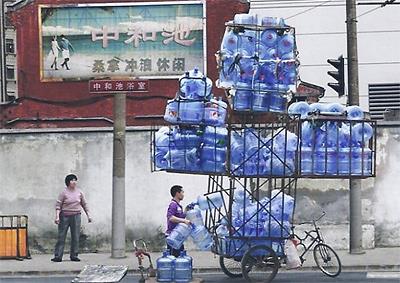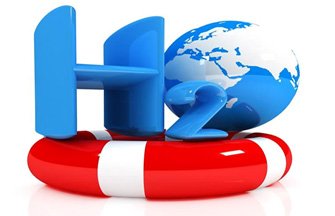
by Fern Shaw | Sep 15, 2015 | Water
Of course, it is! And to prove as much, we’re including a photo of one of our environmentally friendly delivery vehicles. Works really well until such time as they encounter a low bridge. Bada-dish!
You didn’t like that? Then may I draw your attention to a selection of the best jokes from the Edinburgh Fringe Festival that was held in….. (go on, can you guess?) recently?
I bought a muzzle for my pet duck. Nothing flashy, but it fits the bill. Chris Turner
Recently in court, I was found guilty of being egotistical. I am appealing. Stewart Francis
Went to my allotment and found that there was twice as much soil as there was the week before. The plot thickens. Darren Walsh
You can’t lose a homing pigeon. If your homing pigeon doesn’t come back, then what you’ve lost is a pigeon. Sara Pascoe
When my wife and I argue, we’re like a band in concert: we start with some new stuff, and then we roll out our greatest hits.
Frank Skinner
Surely every car is a people carrier? Adam Hess
What’s the difference between a ‘hippo’ and a ‘Zippo’? One is really heavy; the other is a little lighter. Masai Graham
If you think about it a little more – water is loads funny – slipping in water, falling into the koi pond (I really, really did this once, when I was all of 12) fully dressed; water bombs; tossing a glass of water at someone’s mug … it’s FUNNY. I could of course tell you what I believe is the all-time funniest joke about drinking water (which wasn’t all water as the imbiber soon found out) but this is an R-rated page, so perhaps not.
So perhaps water is funnier in motion and visually than in print, but yep, it’s still funny.
For a look at more water humour, have a gander here. If you have any material or funny images you’d like to share, pop them across to us at shelly.crawford@aquaidwatercoolers.co.uk

by Fern Shaw | Sep 15, 2015 | Health and Hydration, Water
Great excitement abounds as we draw closer to the 2015 Rugby World Cup being held in the U.K. this year, starting on 18 September and the final being played at Twickenham on 31 October. One would hope so, as rugby was invented in England in 1823. Legend has it that during a game of football at Rugby School in Warwickshire, a 16 year old student, William Webb Ellis, caught the ball and ran with it towards the opponent’s goal line, rather than following the rules of the times of catching and kicking the ball only.
From our side, as we’re all about things water, we’ve approached keeping hydrated from two angles – keeping yourself hydrated when playing the sport and how to keep yourself hydrated as a fan of the sport!
Perhaps you’re more couch potato than skinny fries when it comes to your sports participation. That’s why when you go from supine to five jumping jacks in a short time, you feel faint, you’re sweating bullets, your heart races, your face turns an interesting shade of puce and you may just feel like purging your most recent meal. This description should give you some idea of why your hydration needs are very different from your favourite rugby team.
Sports Hydration
As you can imagine, the physical and mental energy expended in a rugby match is monumental. In order to keep an athlete’s body (and mind) in peak condition, hydration and rehydration are of paramount importance. An example of just how important hydration is? A player can lose up to 3 to 4 kilograms during one match.
Although this year the temperatures won’t be soaring like they did at the 2013 Rugby League World Cup in Papua New Guinea, where the thermometer reached a cracking 33°C, players always go through strenuous pre-match tests to ensure that they are properly hydrated.
They are weighed before and after training, they have urine tests every day and they fill in wellness charts. If temperatures tend to soar during matches, additional breaks can be implemented during each half. The good news is that these players, their coaches and managers are all highly experienced. So, that’s them covered – now we worry about you, the supporter.
Supporter Hydration
Being a rugby supporter can also be very strenuous – take it from me – at the 2007 Rugby World Cup, there was a lot of supporting, jumping up and down, cheering and moaning going on, and we won’t make too much mention of the quaffing of the many shots in support of one’s national team – usually a concoction of luminescent coloured alcohol. Thirsty work all round, but quenching one’s thirst in the altogether incorrect manner with nary a bottle of water to be seen. Not the right way to stay strong for your team!
So in order to actually enjoy the entire event (instead of giving it your all during one match and spending the remainder of the World Cup hiding underneath your duvet), be kind to yourself:
If you’re fortunate enough to be attending the matches at any of the stadiums:
– Check to see if you can take your own water in with you.
– If you’re walking long distances to get to stadiums, as always, make sure you’ve plenty of bottled water to drink.
– If you’re staying home and know that your supporting is going to be a steady diet of drinking and fry-ups, try to make sure that before you get into supporter mode you drink lots of water. This will mean that you should have more energy in reserve when it comes to the all-important cheering, jumping up and down and singing mentioned beforehand.
Right, you’re sorted, my work here is done. If you need me, I’ll be the one in the Scotland rugby jersey, singing, ’Doe-a-deer’ and ‘Scoooootttlannnd / Scoooooooootttllannnnnd’.
On a more serious note, if you think you or your company will be thirsty during the World Cup, we are so the right people to speak to. Call us on 0800 772 3003 or e-mail us at shelly@aquaidwatercoolers.co.uk

by Fern Shaw | Sep 11, 2015 | Uncategorized
I’ve always loved adages and how they evolve, but I love them especially when they relate to predictions about the weather and the natural world.
For example, one of my favourites, which I’ve never quite understood is:
‘Red sky at night, sailor’s delight. Red sky in morning, sailor’s warning’.
The wonder of this is, is there any truth in this old adage?
Red sky at night, sailors delight
When we see a red sky at night, this means that the setting sun is sending its light through a high concentration of dust particles. This usually indicates high pressure and stable air coming in from the west. Basically, good weather will follow.
Red sky in morning, sailor’s warning
A red sunrise can mean that a high pressure system (good weather) has already passed, thus indicating that a storm system (low pressure) may be moving to the east. A morning sky that is a deep, fiery red can indicate that there is high water content in the atmosphere. So, rain could be on its way.
Mackerel sky and mare’s tails make tall ships carry low sails
This weather proverb originates from a nautical background when different cloud types were used to determine whether sails needed to be lowered. Also referred to as just a ‘mackerel sky’, it is associated with altocumulus clouds while ‘mare’s tails’ refer to cirrus clouds. Both could develop before the instance of a storm which would lead to the lowering of the ships sails. Altocumulus clouds appear when there is a certain level of moisture in the air suggesting rainfall is approaching. The term ‘mackerel sky’ comes from the clouds resemblance to the scales of the mackerel. This terminology is rather lovely if you think about it!
When the wind is out of the East, ‘tis never good for man nor beast
This weather proverb carries some truth if you consider the various air masses that affect Britain and its weather. The air mass coming in from a North-Easterly direction is the Polar Continental; record low temperatures have been seen due to this air mass affecting Britain. This air mass originates in places such as Eastern Europe and Russia to affect Britain with bitterly cold winds in winter and dry, warm winds in summer although it is usually only apparent in Britain during winter (between November and April).
So, now you know. Here’s wishing you red sky nights for the foreseeable future! Or you could do as comedian Tom Parry says (fresh from the Edinburgh Festival): Red sky at night: shepherd’s delight. Blue sky at night: day.

by Fern Shaw | Sep 11, 2015 | Water
I hope you aren’t surprised about the ‘I’ in the title; by now you should be well aware that a lot of this blogging stuff is about me. And why not – it is me that’s writing them after all.
I actually didn’t really trivia my way to fame – no Slumdog Millionaire me – however, I, like millions of humanoids, am fascinated by knowledge of the diverse. With this in mind, I present the 3rd in the series of Did You Know? trivia – facts and factoids to amaze your friends and colleagues with when you’re replenishing your water:
Queen Elizabeth II
The Queen Elizabeth II cruise liner has had one full-time resident for seven years. The passenger, an 87-year-old American widow has lived in a windowless modest cabin for seven years at a rent of £3,500 a month. (Fact for 9 Dec 2008).
“The whole nine yards”
It is believed that the term ‘the whole 9 yards’ came from WWII fighter pilots in the South Pacific. When arming their airplanes on the ground, the .50 calibre machine gun ammo belts measured exactly 27 feet, before being loaded into the fuselage.
Lexicon
The only 15-letter word that can be spelled without repeating a letter is uncopyrightable.
Executable offense
It is an executable offense to allow your pet to mate with a pet of the royal house without permission. I wonder how the Royal Corgis feel about that?
John Smith – lots of!
There are over 30,000 John Smiths in Britain.
Dodgy dicing
In the 1700s, men who ran illegal gambling houses hired a special person to swallow the dice if the police showed up.
Butler
The word ‘Butler’ was brought from France by the Normans around 1066 and is from the French word ‘bouteiller’ which means a man who bottles wine.
In the UK a private members organisation was founded in 1979 called, ‘The Institute of British Butlers’, aimed at providing advice and support for butlers in the UK.

by Fern Shaw | Jul 31, 2015 | Health and Hydration
Aha! Bet that got your attention. Now I have it, can I direct you towards this selection of wrist watches I’m selling? Only joking – however, in all seriousness, when the temperatures start to soar in the summer months, dehydration can occur quicker than you may think.
Here are some quick and easy tips on how to stave off dehydration (and they don’t all involve drinks) –
For Adults:
- Tea – A recent UK study found drinking up to four mugs of black tea with milk a day is just as hydrating as drinking the same quantity of water. Bear in mind though, that the caffeine in tea starts acting as a diuretic (increases fluid loss by causing you to pass more urine) when you exceed around five cups a day, so go easy or sip water in between your mugs of tea.
- Coconut water – Fresh coconut water is naturally isotonic, with a 330ml serving containing more potassium than two bananas plus five other naturally occurring electrolytes. It has one-fifth of the sugar found in fruit juice, plus a little fibre.
- Cucumbers – No matter how you slice ‘em and dice ‘em, cucumbers keep cool at the number one spot on the list of water-logged fruits and vegetables. At 96 percent water, cucumbers have no saturated fat or cholesterol, and are very high in vitamin K, vitamin B6 and iron. Stack slices with watermelon and you’ve a pretty, tasty and water filled snack.
- Watermelon – In the world of thirst quenchers, watermelon weighs in as a major contender. Based on its name, it’s no surprise this fruit is made up of 92 percent water! But its salt, calcium and magnesium is what makes it ideal for rehydration, according to a 2009 study at the University of Aberdeen’s Medical School.
- Lettuce – Iceberg lettuce may be 96 percent water, but it’s not known for much else in the nutrition department. Richer salad greens and sandwich toppers including butterhead, romaine and spinach are more well-rounded choices and still up your hydration.
For Children:
- Make your own ice lollies for a fluid-rich treat. Puree fruit or use no-sugar-added fruit juice and pour into freezer moulds.
- Make sure water is easily accessible for little ones. If they can’t reach the sink or the water tap in your fridge, set up an easy-to-use water dispenser and a few cups in a place where they can reach it.
- Create a reminder system for drinking water. This could be a chart on the fruidge that kids can mark each time they have a serving of water, or, if you’re out and about, a timer set on your phone to remind the family that it’s time to take a drink.
- The same as with the grown-ups (that’s you, that is), keeping hydrated doesn’t have to be water – many fruits and vegetables have a very high water content. Offer watermelon, strawberries, broccoli, celery, cucumbers and other watery fruits and veggies for snacks.





